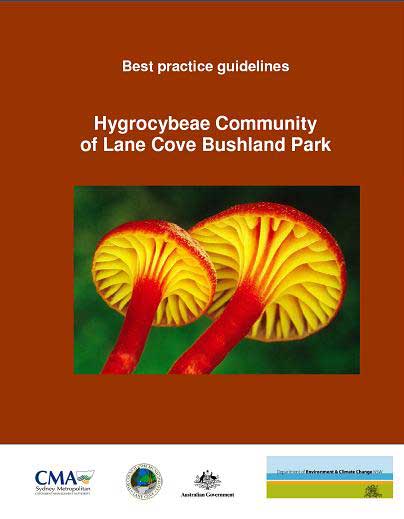Case StudiesLane Cove Bushland ParkIn November 2000 Lane Cove Bushland Park, in metropolitan Sydney, became the first area in Australia for which fungal diversity was the basis for a heritage listing and a consequential conservation plan. The case for having the area listed as heritage site was based on the park's richness of fungi in the family Hygrophoraceae, with the genus Hygrocybe accounting for most of the park's species of the family. The fruiting bodies of the Hygrophoraceae are small mushrooms, with caps generally no more than a few centimetres in diameter and often brightly coloured. There are more than 25 species of Hygrophoraceae in the park. There are of course numerous other fungal species as well as a variety of species of plants and animals, making the park a general treasure trove. This page (http://www.sydneyfungalstudies.org.au/lanecove.htm) on the Sydney Fungal Studies Group's website gives a brief description of the park's features. In 2008 the New South Wales government's Department of Environment and Climate Change (http://www.environment.nsw.gov.au/) published two booklets about the fungi of Lane Cove Bushland Park:
Here is the cover of the first, showing a photograph of Hygrocybe collucera, taken by Ray and Elma Kearney, who prepared the documentation for the heritage listing proposal. So far this species has been found only in the Lane Cove Bushland Park and is listed as an endangered species in New South Wales and you can find that listing here (http://www.environment.nsw.gov.au/determinations/HygrocybeColluceraEndSpListing.htm). Several other Hygrocybe species, thus far found only at the Lane Cove park, are also listed as endangered species. Some of the species in question produce very colourful mushrooms, which should be easily spotted, and all have been actively searched for in the broad Sydney area by members of the Sydney Fungal Studies Group. Either the species are restricted to Lane Cove or, if they do occur elsewhere, they must produce the visible mushrooms rarely. The Lane Cove Hygrophoraceae are an excellent example of a case where we have well-defined species, with their descriptions based on recent studies, but where virtually nothing is known about their behaviour. If any of the species were to be found at another site, a study of what's common to the two sites might give a better idea of the species' habitat preferences and where else you could look for the species. Longer term observation at Lane Cove may help better understand the conditions that trigger the development of the mushrooms of these species. Reference
|
![An Australian Government Initiative [logo]](/images/austgovt_brown_90px.gif)


